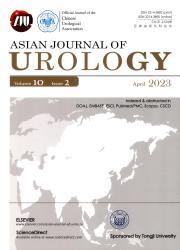静脉尿路造影辅助冲击波碎石治疗放射性输尿管结石的临床效果
IF 2.4
3区 医学
Q2 UROLOGY & NEPHROLOGY
引用次数: 0
摘要
目的比较静脉输尿管造影辅助下透视引导下冲击波碎石治疗放射性透光输尿管结石与标准冲击波碎石治疗放射性不透光输尿管结石的临床效果。方法回顾性分析2014年3月至2021年3月行透视引导下冲击波碎石术治疗输尿管结石的734例患者。主要结果是30天内一次疗程的结石无结石率,定义为未经辅助治疗无残留结石。采用多变量分析来检验静脉尿路造影是否预测治疗成功。此外,我们使用倾向得分匹配来比较结果。结果采用静脉尿路造影方案的患者98例(I组),采用非静脉尿路造影方案的患者636例(N组)。30 d内1次尿路造影无结石率I组为38%,N组为32% (p=0.3)。输尿管镜转换率(p=0.3)和并发症发生率(p=0.7)在I组和n组之间无统计学差异。1例出现皮肤发红被认为是造影剂的并发症。倾向评分匹配检查了88对配对。I组31例(35%)患者治疗成功,N组33例(38%)患者治疗成功(p=0.9)。结论冲击波碎石联合静脉尿路造影可安全有效地治疗透光性结石。本文章由计算机程序翻译,如有差异,请以英文原文为准。
Clinical outcomes of intravenous urography-assisted shockwave lithotripsy for radiolucent ureteral stones
Objective
We aimed to compare the clinical outcomes of intravenous urography-assisted fluoroscopy-guided shockwave lithotripsy for radiolucent ureteral stones and standard shockwave lithotripsy for radiopaque ureteral stones.
Methods
We retrospectively reviewed 734 patients with ureteral stones treated by fluoroscopy-guided shockwave lithotripsy between March 2014 and March 2021. The primary outcome was a stone-free rate with one session within 30 days, defined as no residual stones without auxiliary treatment. The multivariate analysis was used to examine whether the intravenous urography use predicted treatment success. Furthermore, we compared the outcomes using propensity score matching.
Results
Ninety-eight patients underwent the intravenous urography use protocol (Group I), and the remaining 636 patients underwent the non-intravenous urography protocol (Group N). Stone-free rates with one session within 30 days were 38% and 32% in groups I and N, respectively (p=0.3). No statistical differences were observed in the conversion rate to ureteroscopy (p=0.3) or complication rate (p=0.7) between Group I and Group N. One patient who developed skin redness was considered a complication of the contrast medium. Propensity score matching examined 88 matched pairs. Treatment success was obtained in 31 (35%) patients in Group I and 33 (38%) patients in Group N (p=0.9) within 30 days with one session.
Conclusion
Radiolucent stones can be safely and effectively treated by shockwave lithotripsy with intravenous urography.
求助全文
通过发布文献求助,成功后即可免费获取论文全文。
去求助
来源期刊

Asian Journal of Urology
UROLOGY & NEPHROLOGY-
CiteScore
4.00
自引率
3.80%
发文量
100
审稿时长
4 weeks
期刊介绍:
Asian Journal of Urology (AJUR), launched in October 2014, is an international peer-reviewed Open Access journal jointly founded by Shanghai Association for Science and Technology (SAST) and Second Military Medical University (SMMU). AJUR aims to build a communication platform for international researchers to effectively share scholarly achievements. It focuses on all specialties of urology both scientifically and clinically, with article types widely covering editorials, opinions, perspectives, reviews and mini-reviews, original articles, cases reports, rapid communications, and letters, etc. Fields of particular interest to the journal including, but not limited to: • Surgical oncology • Endourology • Calculi • Female urology • Erectile dysfunction • Infertility • Pediatric urology • Renal transplantation • Reconstructive surgery • Radiology • Pathology • Neurourology.
 求助内容:
求助内容: 应助结果提醒方式:
应助结果提醒方式:


